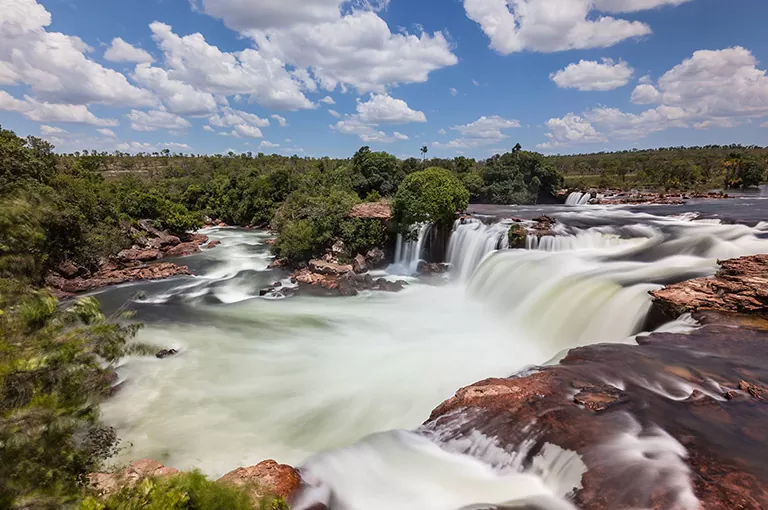
Created in 2001, by the State Law 1,203, the Jalapão State Park (PEJ) is a true ode to nature. Ideal destination for lovers of ecotourism, it is part of the Conservation Units of Integral Protection of the State of Tocantins, destined to the preservation of its natural resources.
Headquartered in the municipality of Mateiros, the Park has more than 158 thousand hectares, with limits to Ponte Alta do Tocantins, São Félix do Tocantins and Novo Acordo.
Nature Beauties of Jalapão
The imposing ecological heritage of Jalapão State Park enchants tourists from all over the world with its chapadões, the freshness of its abundant waters and the savannah climate of the mountains. The paradisiacal landscape of the cerrado is complemented with orange dunes, rivers and springs that lead to waterfalls, besides the gigantic rock formations.
As one of the few places of great concern for the preservation of the Cerrado, the Park guarantees the existence of fauna and flora populations seriously threatened with extinction elsewhere in the country. In PEJ, it is possible to find animals such as lizards, snakes and alligators, as well as maned wolf, puma, Jaguatirica, giant armadillo, giant anteater, as well as groups still little known of fish.
Tourism Rules for the Park
The essential rigor for preservation goes through new rules for visitation, established in 2017 and stipulated by the Nature Institute of Tocantins (Naturatins). The body informs that the driving of tourists to Jalapão State Park can only be done by the 11 tour operators of Tocantins, registered to operate in Jalapão (learn more at: http://www.cadastur.turismo.gov.br /). The measure ensures safety while traveling and concern for the preservation of the ecosystem.
Accompanying the technology, one of the changes is the prohibition of drones for filming and photographing in the dunes. There is no restriction on personal photos, which are not used for commercial purposes. Photo-essays, such as weddings and anniversaries, are allowed, for example, provided they have been previously informed and authorized.
It is also prohibited to bring alcoholic beverages and illegal substances to the dunes. It is not allowed to feed and, of course, to mistreat wild animals. You should not light fires in the Park, as well as remove raw material from the place. Entry of domestic animals other than guide dogs is prohibited. It is also prohibited to swim in the lagoons near the dunes, as well as to open new trails.
The best time to visit
Unlike many other natural sights, Jalapão Park can be visited all year round. It is worth mentioning that the groups to visit are small and quickly exhaust on holidays and months of vacations. There are periods when it hardly rains, such as between May and mid-September, before the sunburns, when the sky has a beautiful shade of blue every day.
On the other hand, September is a great month for those who want to see the famous golden grass in their best presentation. The closer the month, in the dry season, the warmer the days, as well as the nights get cooler. Meanwhile, in the rainy season, the nights are still cool, they do not cool even more, although it is less hot during the day.
What to bring inside the luggage?
Due to the heat, a complete package of sunscreen is essential, as well as a suitcase made up of light clothes and light colors. Swimwear and diving goggles, for use in rivers, as well as sunglasses, cap and hat are also welcome. No shoes or uncomfortable shoes: wear sneakers. There is no need for heavy clothing, at most, knit sweaters with long sleeves. Take a warm coat, as it can get cold during the night. Against mosquitoes, do not forget the repellent. To avoid dehydration, charge a squeeze and so your flashlight does not run out of charge, extra batteries. As for any trip, do not give up on your personal remedies. In some places the cell phone is only for taking a photo, because the signal is bad, but it is an invitation to experience nature.
How to arrive to Jalapão?
Starting from Palmas, capital of Tocantins, tourists have two ways to get to the State Park, by land access. The shortest, with 341 km is the North: from the highway TO-020, stretch Palmas – Novo Acuerdo (115 km), followed by TO-030, in the New Agreement section – São Félix do Tocantins (147 km) and , Finally by the TO – 110, in the connection between. (79 km).
By the South, the way is bigger and more challenging. The beginning is “tranquil”: it is 60 km of road paved by the TO-050, section Palmas – National Harbor. Then there is 135 km of a partially paved TO-255, up to Tocantins High Bridge. From there, it is 165 km of land, to the municipality of Mateiros, totaling 360 km.











